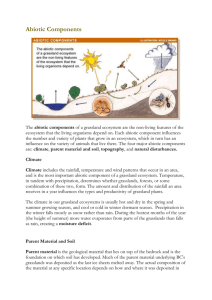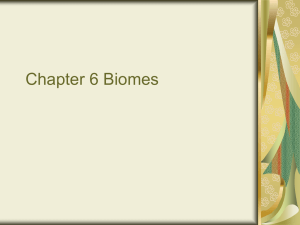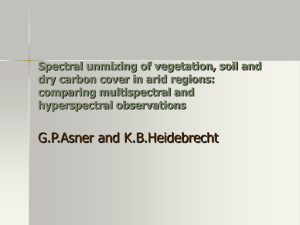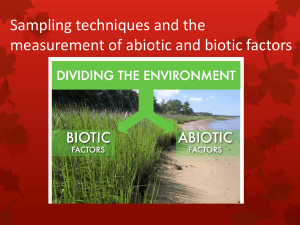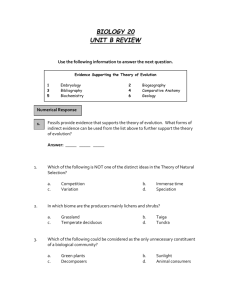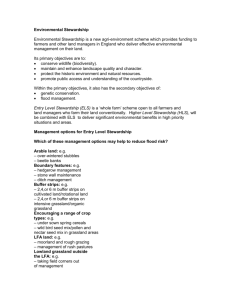Study of an Ecosystem
advertisement
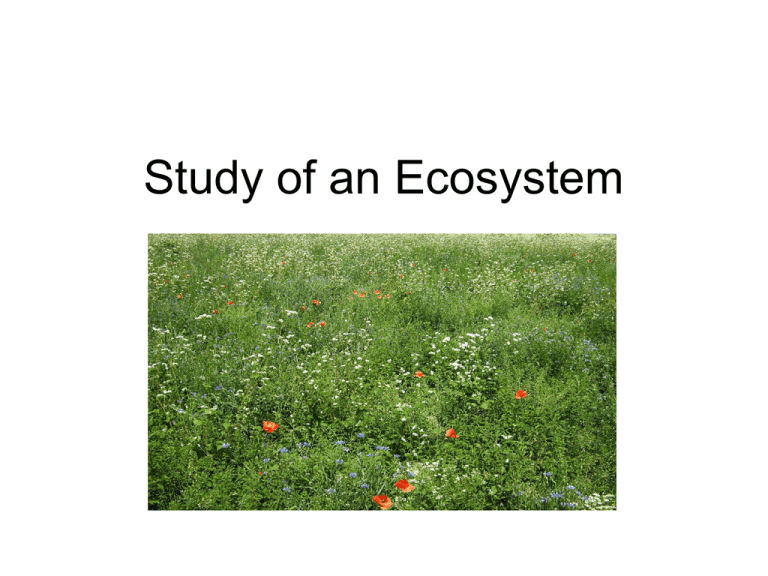
Study of an Ecosystem You are required only to study any one ecosystem, and to know five animals and five plants from your ecosystem. Examples of Flora (plants) that live in a grassland 1. 2. 3. 4. 5. Examples of Flora (plants) that live in grassland. 1. Grass 2. Clover 3. Dandlion 4. Buttercups 5. Nettles Plants Grasses Clover Buttercups Dandelions Daisies Nettles Poppies Thistles Dock Primrose Bluebell Examples of Fauna (animals) that live in a grassland? 1. 2. 3. 4. 5. Fauna that live in a Grassland Habitat. 1. Snail 2. Squirrel 3. Bee 4. Ant 5. Woodlouse Animals H = herbivore, C = carnivore, O = omnivore, D = detritus feeder (detritus is dead and decomposing organisms) » Earthworms (D) Rabbits (H) Ladybirds (C) » Slugs (H) Foxes (C) Wasps (H, C) » Beetles (C, H, O) Thrushes (C) Moths (H) Caterpillars (H) Snails (H) Badgers (O) Bees (H) Spiders (C) Hedgehogs (O) Butterflies (H) Aphids (H) Blackbirds (O) Vertebrae: animals with a backbone e.g frogs, rabbits, foxes Invertebrates: Animals which do not have a backbone e.g. snails, slugs, worms, woodlice Grassland: Draw a plan view map of the grassland habitat Use a key on the map to identify locations of trees, roads, footpaths etc. Use a compass to identify direction of north • The study of an ecosystem involves studying a number of sample habitats, as follows: • Mapping • identifying plants and animals • estimating the numbers of plants and animals • measuring the environmental (abiotic) factors • presenting the information Apparatus to Identify organisms You must be able to draw, identify and give a function of each piece of equipment. Equipment Pooter Pitfall Trap Cryptozoic Trap Beating Tray Quadrat Diagram Function Device Procedure Collected Trowel Dig Plants, animals in soil Pooter Suck Insects Beating Tray Shake bushes Crawling animals Pitfall trap Sink into soil or sand Crawling animals Sweep net Sweep through grass Insects Method Procedure Tullgren Funnel Heat Soil (using a lamp) Small organisms from soil Baerman Funnel Heat soil in water Small organisms from mud Mammal traps Set the trap Mammals Potassium permanganate solution Pour onto soil Cryptozoic trap Place on ground Organisms Earthworms Slugs, snails, worms, woodlice A key is used to identify and name organisms A qualitative study records the presence or absence of species. A quantitative study records the number of each species. • A quantative study of plants in a habitat involves using: • Quadrats: Advantages of Quadrats: 1. quick & easy to obtain results 2. Widely used so results are comparible Disadvantages: 1. Can only be used to identify slow moving animals 2. Cannot be used for big things eg. Big trees. Percentage Cover – The area of ground occupied by ariel parts of plants • Transects: (a) Line transect (rope marked at intervals – record what touches the line). (b) Belt transect (equivalent to quadrats taken in a line – methods used are the same as for quadrats). Quantitative studies can be: • subjective (i.e. a personal judgement is made as to the number) • objective (i.e. an independent method of calculating numbers is used) Subjective methods are not recommended, because they depend on individual judgements, which may vary from person to person. • A quantitative study of animals in a habitat involves using: the capture–recapture method, i.e. Number = C 1st × C 2nd _____________ M 2nd Method: 1. Go out first day and collect small animals e.g. snails 2. Mark animal on undersurface using non toxic nail polish count and release snails C1 3. Return a week later and capture a number of snails 4. Record the number you catch C2 . Count the number of sails marked on the first visit you marked M1. 5. Release the snails back into the same place. 6. Do calculation Three sample abiotic factors Ecosystem Sample factors Grassland Air temperature Thermometer Soil pH pH meter or universal indicator Light intensity Measured by Light meter • Organisms show many adaptations that allow them to survive in their habitat. • The results of a study can be presented in tables, lists, charts, graphs, diagrams, etc. Effects of abiotic factors Ecosystem Abiotic factor Influence Grassland Air temperature Temperature differences in different parts of the grassland will affect how well the plants (and animals) grow Soil pH Soil pH will favour some plants and therefore some animals Light intensity Grasses grow better at higher light intensities


